Spaghetti Carbonara is a Roman pasta that’s as rich in flavor as it is in texture. Crispy guanciale or pancetta and pasta are tossed in a velvety sauce of Pecorino Romano cheese, fresh eggs, and starchy pasta water. Topped with more Pecorino and coarsely ground black pepper this recipe is a favorite we turn to time and time again.
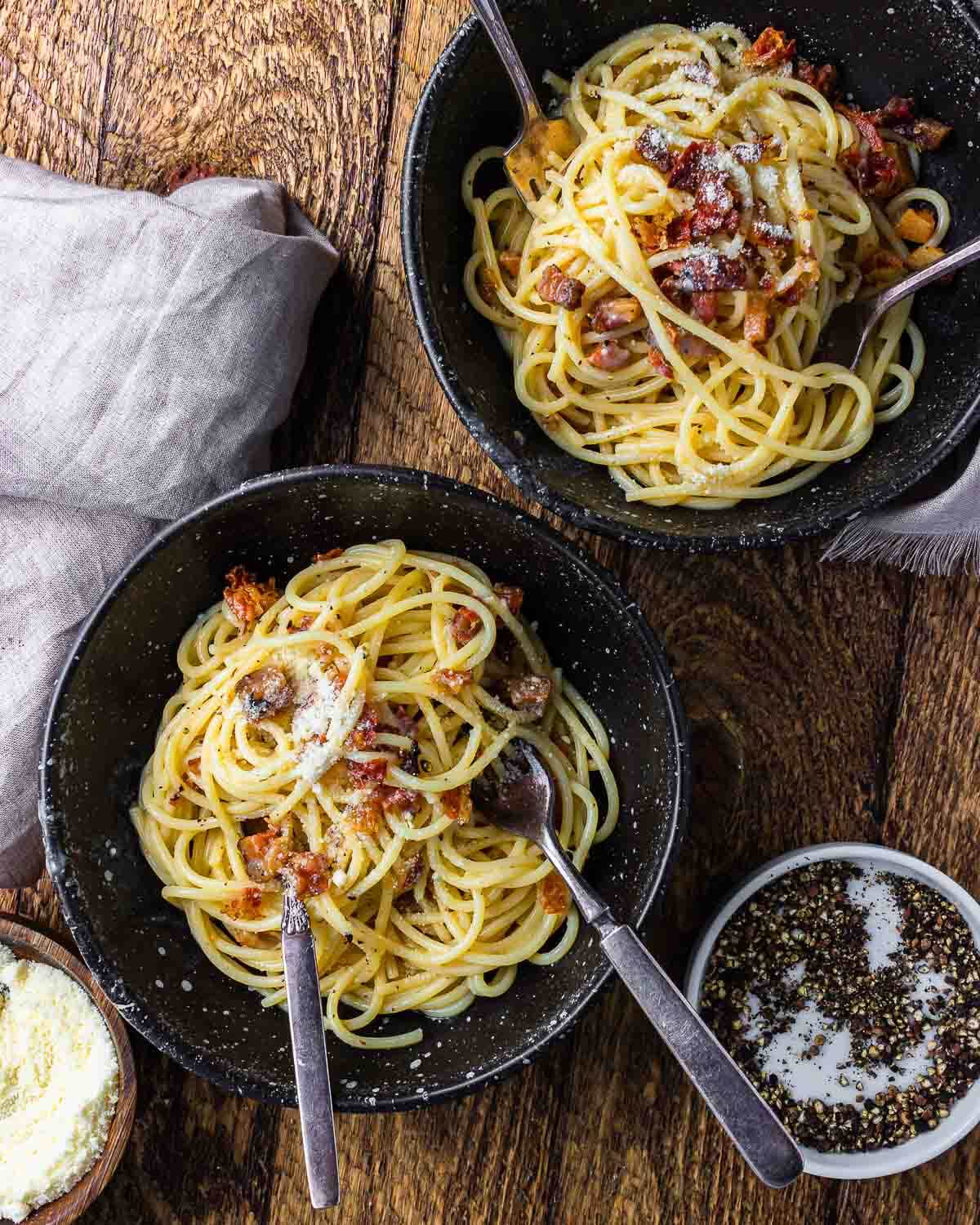
This post may contain affiliate links. Our disclosure policy.

Simplicity with quality ingredients
Spaghetti Carbonara is a dish that is often imitated and complicated with ingredients that aren’t needed, such as cream and butter.
But true pasta Carbonara, the version that hails directly from Rome, is anything but complicated.
The simplicity lies with the fact that there are just a few ingredients: Pecorino Romano cheese, eggs, guanciale (cured pork jowls), black pepper, and of course al dente pasta and the water it’s cooked in.
Much like Cacio e Pepe or pasta alla Gricia, the key to Carbonara lies in the preparation. By following the steps we’ve outlined here and in our video, you’ll be able to make restaurant-quality Carbonara in your own home.
And if you’re a Carbonara fan, try my recipe for Pasta alla Zozzona which is a mashup of Carbonara and Amatriciana!
How to make spaghetti carbonara
Each number corresponds to the numbered written steps below.
- Bring a large pot of salted water to boil. Note: Use half as much salt due to the saltiness of the guanciale/pancetta and pecorino cheese. Dice the guanciale or pancetta. Freezing it for 30 minutes or so will allow easier cutting, but it’s not necessary.
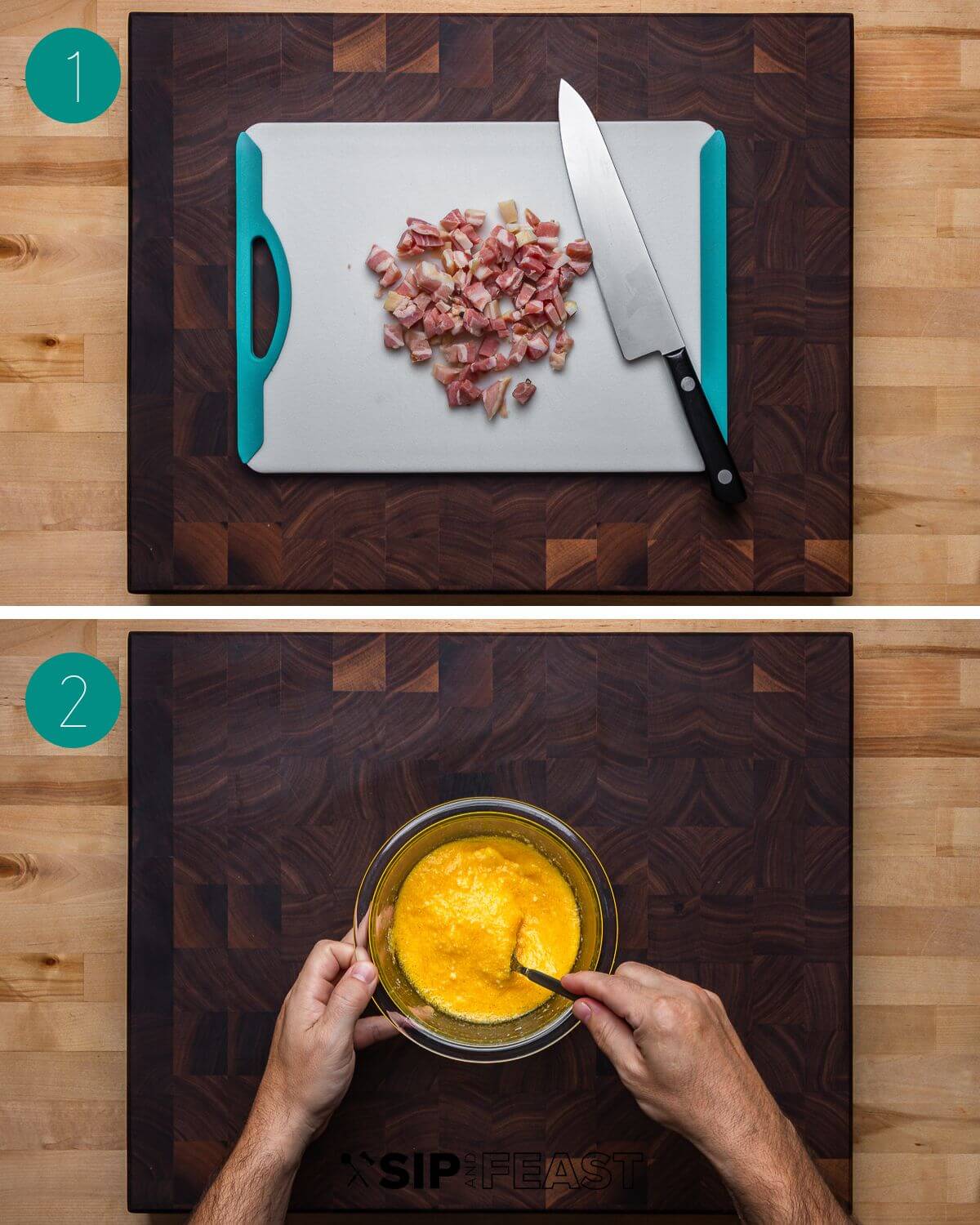
- Beat the eggs and Pecorino together in a bowl and set aside.
- Heat a large pan to a bit less than medium heat. Saute guanciale until most of the fat has rendered (about 12-15 minutes). About halfway through the rendering process, cook the spaghetti until a touch less than al dente.
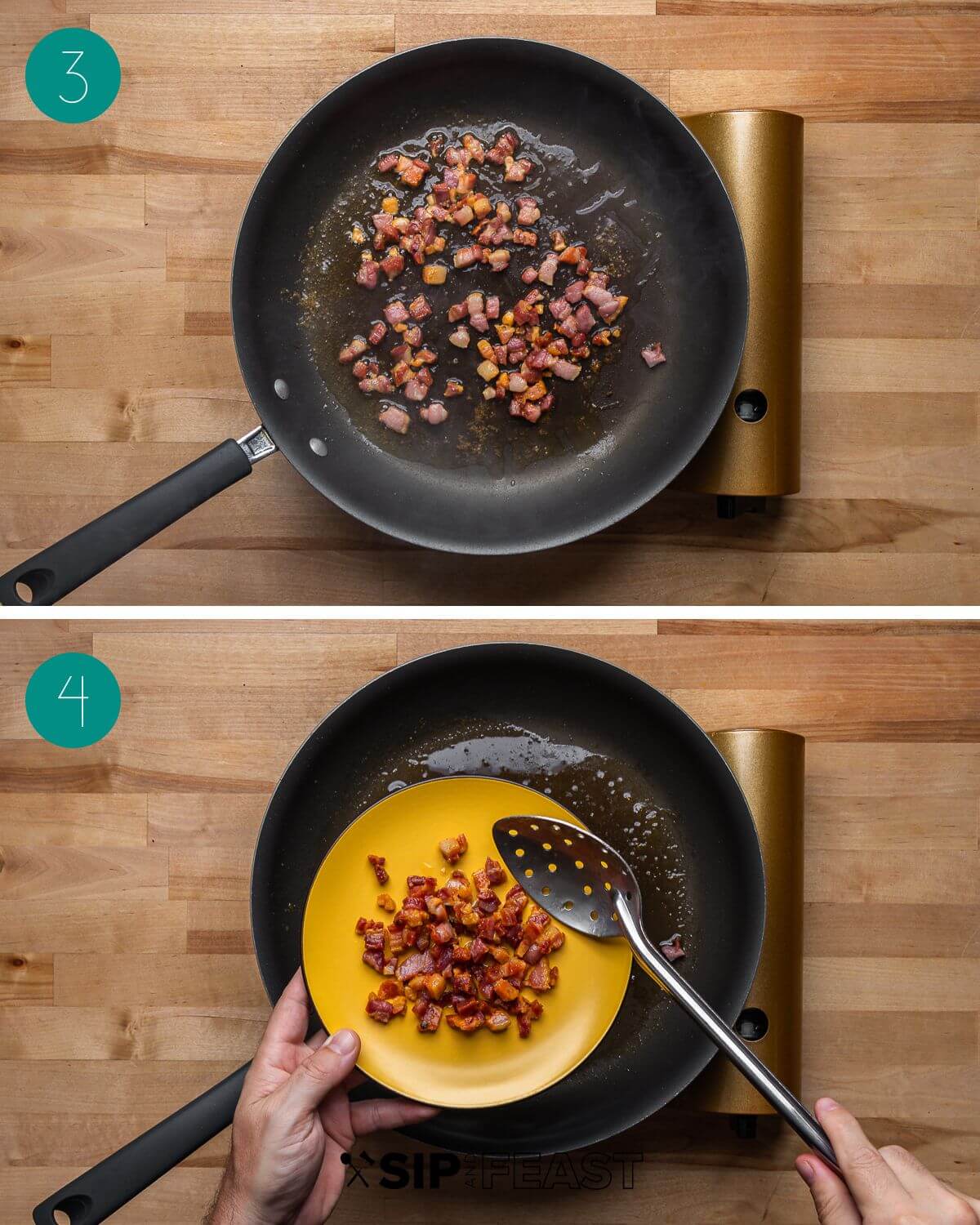
- Remove most of the guanciale or pancetta from the pan and set it aside on a plate.
- Place the drained spaghetti into the pan along with 2 ounces of pasta water. Mix the spaghetti with the guanciale fat.
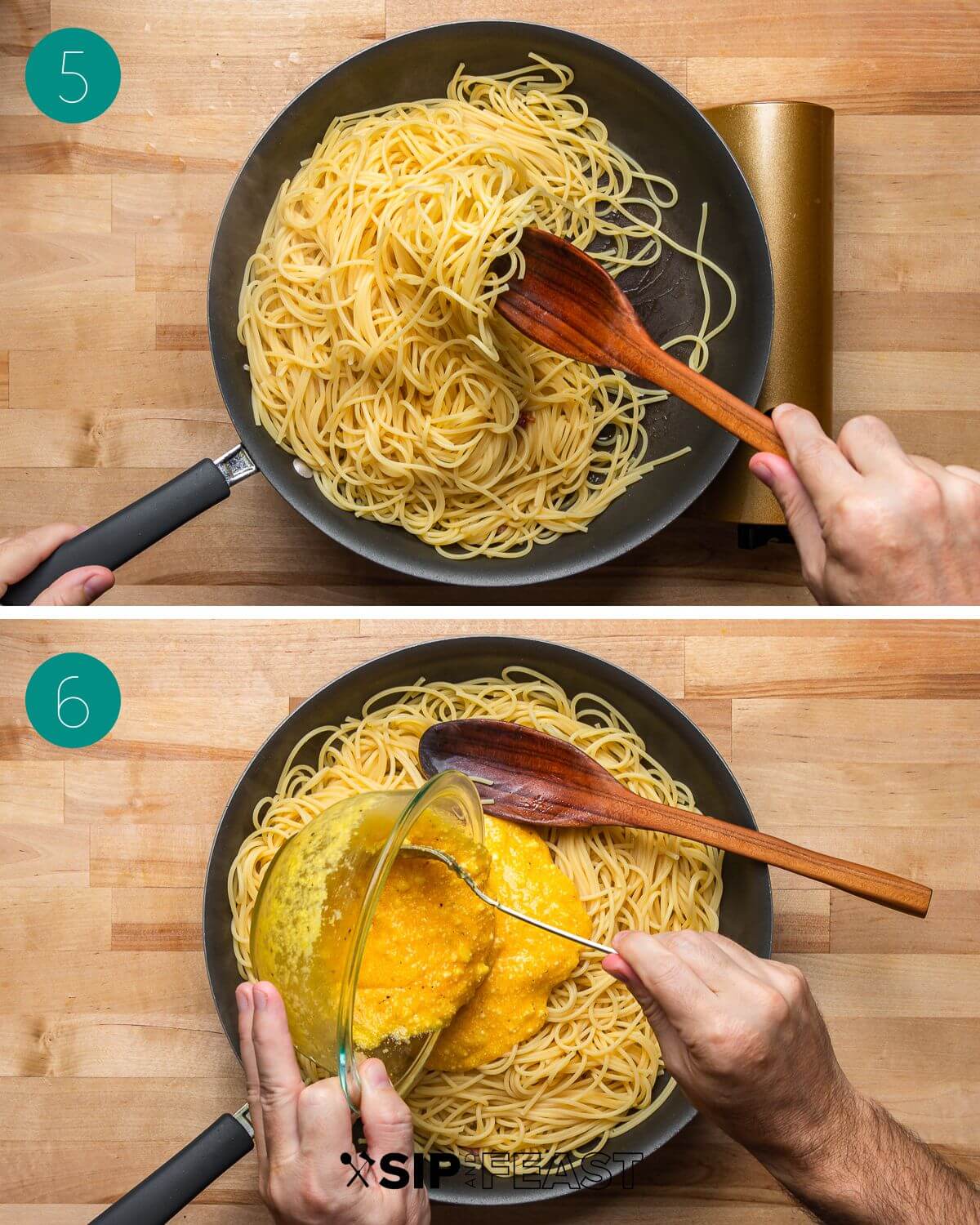
- Remove the pan from the heat once the spaghetti reaches al dente. Wait 30-45 seconds then add the egg and cheese mixture. Mix quickly and/or toss to coat.
- If the pasta is too dry add a touch more of the reserved pasta water to loosen it up. Add the guanciale back to the spaghetti and toss once more adding more pasta water if needed.
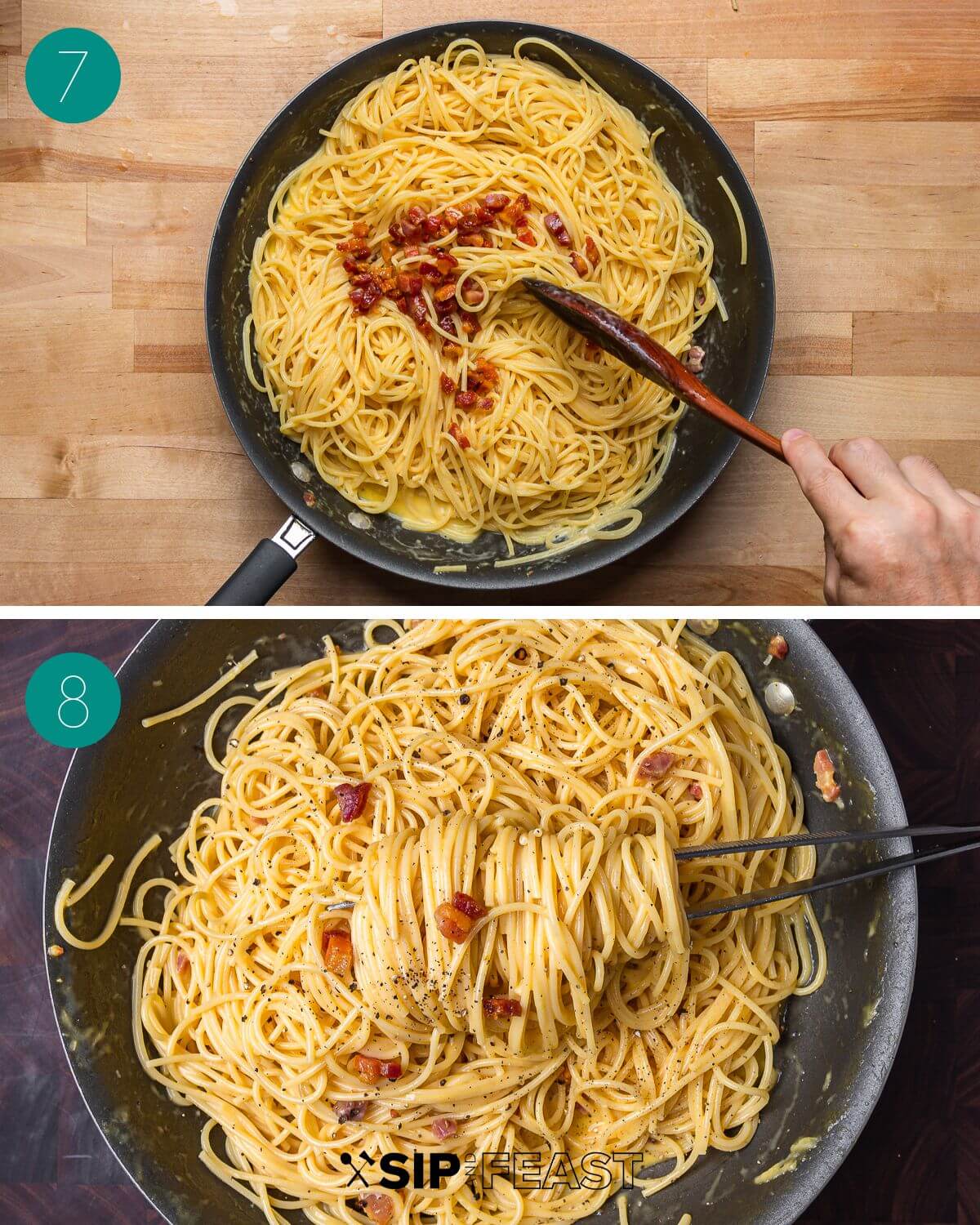
- Taste test and adjust black pepper to taste. A good amount is recommended. Serve with grated Pecorino. Enjoy! Note: Reserving a bit of the crispy guanciale for topping each serving at the end is a nice touch.
Top tips
- A word on guanciale. Guanciale is a salty cured pork product made from pork jowls. This product can be found at the deli counter at Italian specialty stores and we’ve even seen it sold at Whole Foods. It is the fat that is traditionally used in 3 of the Roman pastas, including Carbonara. While guanciale is preferred, we realize that it’s not easily accessible so if you can’t find it you can use pancetta, similar to how we did in our Bucatini Amatriciana recipe.
- The cheese. Since pasta Carbonara is a Roman pasta, the cheese that is used is Pecorino Romano. Pecorino is a salty sheep’s milk cheese that has a distinct flavor. We do recommend you use Pecorino for this recipe but if you simply cannot find it, you could use Parmigiano Reggiano. If you do use Parmigiano, you may need to add a little salt since Pecorino is saltier than Parmigiano.
- Avoid scrambled eggs! Successful Carbonara lies in the timing and technique. It’s so important to make sure you remove the pan from the heat and allow 30-45 seconds to pass before you add the egg and cheese mixture. Once you’ve added the mixture, be sure to mix thoroughly and avoid letting the egg mixture sit on the bottom of the pan. Not following these steps may result in a scrambled egg-like consistency.
- Save your pasta water. As with almost all of our creamy pasta recipes, we urge you to save your pasta water. The pasta water is actually part of the sauce and can also help to reconstitute the sauce if it dries out at all.
More pasta recipes you’ll love
If you love spaghetti Carbonara we think you’ll love these other simple pasta recipes that include just a few ingredients.
Spaghetti Carbonara
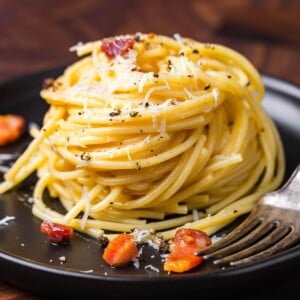
Ingredients
- 1 pound spaghetti
- 6 ounces guanciale or pancetta diced
- 4 large eggs beaten
- 1 cup Pecorino Romano cheese grated
- 1 teaspoon black pepper coarsely ground
- 1 1/2 cups pasta water will most likely not need all of it
Want To Save This Recipe?
Instructions
- Bring a large pot of salted water to boil. Beat the eggs and Pecorino together in a bowl and set aside.
- Heat a large pan to a bit less than medium heat. Saute guanciale until most of the fat has rendered (about 12-15 minutes). About halfway through the rendering process begin cooking the spaghetti until a touch less than al dente.
- Remove most of the guanciale from the pan and set it aside on a plate. Place the spaghetti into the pan along with 2 ounces of pasta water. Mix the spaghetti with the guanciale fat then remove the pan from the heat once the spaghetti reaches al dente.
- Wait 30 seconds then add the egg and cheese mixture. Mix quickly or toss to coat. If the pasta is too dry add a touch more of the reserved pasta water to loosen it up.
- Add the guanciale back to the spaghetti and toss once more adding more pasta water if needed. Taste test and adjust black pepper to taste. A good amount is recommended. Serve with grated Pecorino. Enjoy!
Notes
- The key to making the carbonara creamy is to mix the egg/cheese into the guanciale/pancetta fat and pasta water thoroughly.
- Remember to wait 30-60 seconds before adding the egg and cheese mixture to avoid scrambled eggs. Mix quickly as well!
- No salt was added due to the saltiness of the guanciale and the pecorino cheese.
- Carbonara is best eaten right away instead of saving for leftovers.
Nutrition
Nutrition information is automatically calculated, so should only be used as an approximation.
Follow Me
This recipe was originally published on February 26, 2019. It was completely updated on September 2, 2022.






